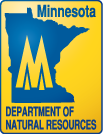DNR news releases, March 24, 2014
MINNESOTA DNR NEWS #22 March 24, 2014
All news releases are available in the DNR’s website newsroom at www.mndnr.gov/news.
Follow the DNR on Twitter @mndnr.
IN THIS ISSUE
Bald eagles on spring migration back to Minnesota
DNR will highlight fishing, hunting and hiking at Northwest Sportshow
DNR question of the week: Wildfire prevention
DNR NEWS – FOR IMMEDIATE RELEASE
Bald eagles on spring migration back to Minnesota
Bald eagles are migrating back to Minnesota and may be seen in large numbers across parts of the state over the next few weeks, according to the Department of Natural Resources.
"Ice is breaking up along the rivers, so it's definitely time for folks to keep their eyes out," said Lisa Gelvin-Innvaer, DNR regional nongame wildlife specialist. "It all depends on the weather. It’s typical to see eagles coming through our area in mid-to-late March, as waters begin to open up and snow melts.”
Only two states, Florida and Alaska, have greater nesting populations of bald eagles than Minnesota. In 2005, researchers estimated there are more than 1,300 active nests in Minnesota.
Fall migration typically occurs as lakes and rivers freeze over, since most eagles prefer a diet of fish. Bald eagle wintering grounds ideally contain open water, ample food, limited human disturbance and protective roosting sites.
Not all bald eagles migrate southward in the fall, Gelvin-Innvaer said. In southern Minnesota, it's common for some eagle pairs to stay the winter, especially during milder winters.
“This winter we’ve had a lot more snow and cold temperatures than last year,” Gelvin-Innvaer said. “It makes carrion a bit harder for eagles to find.”
Bald eagles that stay local may begin courting and nesting as early as December or January. Other bald eagles return to their breeding territories, as soon as a food source is available.
"Eagle migration hotspots are a bit of a moving target, so it's hard to say where the eagles are right now," Gelvin-Innvaer said. "In Minnesota, the biggest migrations tend to be along the Minnesota River corridor, the north shore of Lake Superior and around Lake Pepin in southeastern Minnesota."
Adult bald eagles are easily identified by a white head and tail contrasting with a dark brown body. Bald eagles attain full adult plumage in their fourth or fifth year. In flight, bald eagles are sometimes confused with turkey vultures. However, bald eagles have a tendency to soar on flat, board-like wings, while turkey vultures fly with their wings in a v-shape.
Bald eagles are an example of how they and many other wildlife species benefit directly from donations made to the nongame wildlife checkoff on Minnesota tax forms. Checkoff dollars fund research, surveys and education for more than 700 nongame wildlife species. Each dollar donated is matched by funds from the Reinvest In Minnesota account.
The DNR’s nongame wildlife program is now streaming live video of a nesting pair of bald eagles on its website at www.webcams.dnr.state.mn.us/eagle. For additional information on bald eagles or where to view them, go to www.mndnr.gov/birds/eagles/winter_wabasha.html or www.mndnr.gov/snapshots/birds/baldeagle.html.
-30-
DNR NEWS – FOR IMMEDIATE RELEASE March 24, 2014
DNR will highlight fishing, hunting and hiking at Northwest Sportshow
Outdoor enthusiasts can learn about fishing, hunting, hiking trails, water safety and much more by visiting the Minnesota Department of Natural Resources booths at the Northwest Sportshow, March 26-30 at the Minneapolis Convention Center.
DNR specialists will be available to answer questions at the main DNR booth located in Lobby D. The DNR License Center will be selling state parks stickers, and fishing and hunting licenses at the booth.
Attendees also can visit the DNR’s invasive species information booth in Lobby C to pick up educational materials and talk with invasive species staff and conservation officers specializing in invasive species issues. The booth will have invasive species specimens and models for visitors to examine.
The DNR Enforcement Division will offer an interactive LaserShot shooting range for youth and adults. Participants can test their skills at one of four shooting simulation stations. The range is located in Room 101J, next to the Lobby C entrance.
Youth interested in learning how to safely ride an all-terrain vehicle (ATV) can take a ride on the ATV safety training simulator also located in Room 101J. Staff will be available to demonstrate how to properly fit the vehicle to the rider and answer questions about safety equipment and gear.
Business owners who are required to complete lake service provider training can attend a class on Thursday, March 27, from 9:30 a.m. to 12:30 p.m. For more information about the training and to register for the class, visit the DNR website at www.dnr.state.mn.us/lsp.
Daily admission to the Northwest Sportshow is $11 for adults 16 and older. Youth 15 and younger are admitted for free. On March 27, seniors 62 and older will receive a discounted admission of $8 for the day. Active military personnel receive free admission with a valid ID.
-30-
DNR QUESTION OF THE WEEK
Q: With the potential for wildfire season this spring, is there anything people can do now to protect their homes and cabins?
A: Now, while the snowpack is still here, burn brush piles. If there is less than 3 inches of snow on the ground, a burning permit is required. Check with a local forestry office.
Late winter is the best time to prune trees. Look at the trees and shrubs within 100 feet surrounding the cabin or house. Eliminate ladder fuels by pruning 6 to 10 feet up from the ground. Thin out evergreen trees so branches are 10 feet apart. Maintain a 10-foot space between the crowns of trees. Clean roof and gutters of any wood any pine needles, leaves or debris. Prune off tree branches touching the house. Move wood piles outside a 30-foot zone surrounding the cabin or house. Make sure the chimney has a spark arrestor.
For more information go to www.mndnr.gov/firewise.
-Linda Gormanson, regional Firewise specialist



